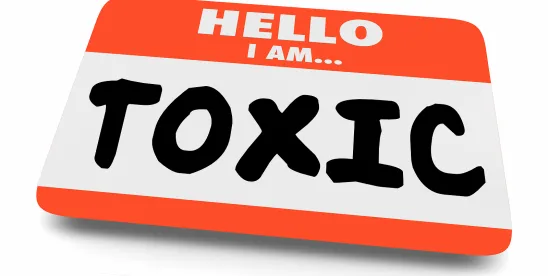Longtime efforts by the California Office of Environmental Health Hazard Assessment (OEHHA) to amend the so-called “short-form” safe harbor warnings for California’s Proposition 65 appear to be nearing completion. On 13 June 2024, OEHHA released a 15-Day Notice of Modification to proposed amendments to Proposition 65 regulations. Assuming that OEHHA adopts the modified proposal, the amended regulations would alter the so-called “short-form” safe harbor warnings for consumer products and food, and it would amend safe harbor warnings for internet and catalog sales, automotive parts, and recreational marine vessel parts.
Proposition 65, more formally known as the Safe Drinking Water and Toxic Enforcement Act of 1986, was enacted by voter initiative and codified at California Health and Safety Code sections 25249.5 through 25249.14. Proposition 65 prohibits businesses employing ten or more persons from knowingly and intentionally exposing Californians to chemicals known to the state to cause cancer or reproductive harm without first giving a clear and reasonable warning. No warning is required if the business can prove that the exposure falls below certain thresholds, but those thresholds are often either so low or uncertain that business will often provide a warning for even infinitesimally low concentrations of listed chemicals if a chemical can be detected.
The Proposition 65 statute does not define what constitutes a clear and reasonable warning. As a result, OEHHA has adopted regulations approving safe harbor language that, if used, constitutes a clear and reasonable warning.
During a rulemaking in 2016 to require more explicit warnings, several stakeholders raised concerns that safe harbor warning language that was then under consideration would not fit on small products, labels, or containers without crowding out other necessary information. In response to those concerns, OEHHA included an optional “short-form” warning that could be placed directly on a product, its label, or its immediate container or wrapper. Unlike the standard warning, businesses were not required to identify a chemical or chemicals in a short-form warning and instead were required to identify the endpoint risk (i.e., cancer, reproductive harm, or both). The regulations permitted use of the short-form warning on any consumer product, not merely small packages.
Following adoption of the short-form warning regulations, OEHHA was surprised to find that many businesses were using the short-form warning for a wide variety of consumer products, regardless of product or package size. In addition to perceived overuse of the short-form warning, in OEHHA’s judgment, the lack of chemical identification significantly limited the usefulness of the warnings to consumers, because consumers could not research the risk associated with the chemicals that were present.
Accordingly, OEHHA proposed new regulations concerning the short-form warnings in October 2023. The proposals have been the subject of substantial public comment. Now that public comments have been received, under California’s Administrative Procedure Act, OEHHA must give 15 days’ notice before adopting regulations that differ from the original, proposed regulations, because the changes are considered substantial but “sufficiently related” to the regulations that it initially proposed. The public has until 28 June 2024 to comment on the proposed revisions, and the agency must respond to any such comments in its final statement of reasons for adoption of the regulation. However, no public hearing needs to be held prior to adoption of final regulations. In practice, issuance of the 15-day notice signals that OEHHA is likely close to adopting the final regulations.
NEW SHORT-FORM, SAFE HARBOR WARNINGS
Assuming that OEHHA adopts the revised regulations, the regulations would materially change usage of the so-called short-form safe harbor warning. Under the amended regulations, short-form warnings would have to name at least one chemical for each type of exposure pathway (cancer or reproductive harm) that is present. Moreover, additional verbiage has been added to the warning.
Under existing regulations, each form of warning must be proceeded by an international warning symbol consisting of a black exclamation point in a yellow equilateral triangle with a bold black outline: ![]() The word “WARNING” in all capital letters and in bold print follows the symbol. The new regulations continue the requirement for the warning symbol but permit two alternatives to highlight the California-specific nature of the warnings. In addition to the word, “WARNING,” businesses could commence the warning with the phrases “CA WARNING:” or “CALIFORNIA WARNING:” in all capital letters and in bold print.
The word “WARNING” in all capital letters and in bold print follows the symbol. The new regulations continue the requirement for the warning symbol but permit two alternatives to highlight the California-specific nature of the warnings. In addition to the word, “WARNING,” businesses could commence the warning with the phrases “CA WARNING:” or “CALIFORNIA WARNING:” in all capital letters and in bold print.
The proposed regulations would also permit one of two versions of text to follow the signal words “WARNING:,” “CA WARNING:,” or “CALIFORNIA WARNING:.” In the case of a carcinogen, the two options are:
- “Cancer risk from exposure to [name of chemical]. See www.P65Warnings.ca.gov.”
- “Can expose you to [name of chemical], a carcinogen. See www.P65Warnings.ca.gov.”
As another example, two approved, short-form warnings for multiple chemicals, one a carcinogen and another a reproductive toxicant, are:
- “Risk of cancer from exposure to [name of chemical] and reproductive harm from exposure to [name of chemical]. See www.P65Warnings.ca.gov.”; or
- “Can expose you to [name of chemical], a carcinogen, and [name of chemical], a reproductive toxicant. See www.P65Warnings.ca.gov.
There are other safe harbor short-form warnings for reproductive toxicants or chemicals that are both carcinogens and reproductive toxicants (e.g., lead).
SHORT-FORM WARNINGS FOR FOOD
The new short-form warnings for food follow a pattern that is similar to warnings for consumer products, but with refinements that direct consumers to information about food. The short-form food warnings refer to a different website: See www.P65Warnings.ca.gov/food.
SIZE AND PLACEMENT OF SHORT-FORM WARNINGS
Existing regulations require that a short-form warning be in a type size no smaller than the largest type size used for other consumer information on the product. That size requirement has especially impeded the use of short-form warnings on food products and dietary supplements, where nutritional information must be provided in relatively large fonts.
The proposed regulations eliminate the requirement that short-form warnings appear in font as large as the largest consumer information. That change will facilitate the use of short-form warnings on food products, in particular. Two, existing requirements for font size would remain.
Short-form warnings would need to appear in a minimum of six-point type. But bear in mind that the six-point size is a minimum, not an across-the-board standard. The regulations would still require that short-form warnings be displayed with “such conspicuousness as compared with other words, statements, designs or devices on the label, labeling, or sign, as to render the warning likely to be seen, read, and understood by an ordinary individual under customary conditions of purchase or use.” In theory, that general and imprecise standard creates opportunities to challenge the sufficiency of short-form warnings in six-point type, particularly if the warning is small in comparison to other font sizes used on labels or signs or located remotely from other consumer information.
INTERNET AND CATALOG WARNINGS
The new regulations would amend internet and catalog safe harbor language to track the changes discussed above. The initial, draft regulations proposed in October 2023 would have required that one of the safe harbor warnings also appear on or with the product when delivered to the customer. In its updated regulations, OEHHA proposes to delete the requirement to warn again at the time of delivery.
PRACTICAL CONSIDERATIONS
Each of the new, alternative short-form warnings raises similar concerns. For consumer products other than food, the short-form warning adds additional verbiage that will make it nearly as long as the full-length warning. Given the additional verbiage, will a short-form warning fit on smaller packages or labels? In the case of food, elimination of the requirement to match the largest font size of other consumer information may make the use of short-form warnings practicable, notwithstanding the additional verbiage. The short-form warning will closely mirror the content and length of the standard warning but will be shorter in length overall, so it seems likely that many companies will default to using the short-form warning moving forward, as opposed to the standard warning.
TRANSITION PERIOD FOR CONSUMER PRODUCTS AND INTERNET PURCHASES
The proposed regulation adopts a three-year transition period (up from two-years in the original proposal). Warnings that comply with existing regulations will continue to constitute clear and reasonable warnings on consumer products manufactured and labeled prior to three years after the effective date of the regulation. Similarly, internet retailers will not be responsible for posting the new warnings for three years following adoption of the regulations. Warnings that have been approved as part of a consent judgment may also continue to be used and will not be required to adopt the new language.
PASSENGER OR OFF-HIGHWAY MOTOR VEHICLE PARTS EXPOSURE WARNINGS
The proposed regulations adopt new safe harbor warning language and methods for passenger or off-highway motor vehicle “parts.” Vehicle “parts” include, but are not limited to, replacement parts such as plastic and metal fittings and housings, bulbs, nuts and bolts, belts, filters, and the like. Packaged service chemicals—such as engine oil, brake fluid, coolant (antifreeze), and transmission fluid—are excluded from the definition of “parts.”
The new warnings apply to exposures that occur during the “purchase, handling, or installation of a part.” The regulation would apply to aftermarket parts for passenger vehicles such as automobiles, sport utility vehicles, and light trucks, and off-road vehicles such as motorcycles, snowmobiles, and all-terrain vehicles.
Many parts already have Proposition 65 warnings, and these new, tailored warnings would not be required for safe harbor protection. Businesses may continue to utilize the more generally applicable safe harbor warnings for consumer products. In that case, why would businesses opt to use the new warnings? OEHHA’s proposed regulations provide the following answer: “This regulation simply allows additional tailored warning options for businesses. Businesses that wish to use the new tailored warning may do so once the regulations become effective or at any time afterwards.”
The new parts warnings may be introduced one of three ways: by the words “WARNING:,” “CALIFORNIA WARNING:,” or “CA WARNING:” in all capital letters and bold print. The warning must be followed by the following language:
Handling passenger or off-highway motor vehicle parts can expose you to chemicals such as phthalates and lead, which can cause cancer and reproductive harm. To minimize exposure, service the vehicle in a well-ventilated area, wear gloves, and wash your hands. For more information see www.P65Warnings.ca.gov/motor-vehicle-parts.
For posted warning signs (e.g., at retail locations), the warnings for phthalates and lead may not be added to, removed, or substituted. For all other methods of providing warnings (e.g., on product labels), the product manufacturer or importer may substitute a chemical name in the warning if the product will not expose a consumer to lead or phthalates at a level that requires a warning.
The amended regulation would afford retailers greater flexibility in placing signs to provide warnings. Retailers could provide warnings using a five-inch by five-inch sign located in several locations within stores. The retailer may choose whether to post the sign at each retail point of sale or as part of each display of parts to be covered by the warning.
There is no transition or phase-in period for the parts warnings, because products that have compliant warnings do not need to be changed.
RECREATIONAL MARINE VESSEL PARTS EXPOSURE WARNING
The proposed regulations also adopt new safe harbor warnings and methods for “recreational marine vessel parts,” which mirror the new proposed safe harbor warnings and methods for passenger or off-highway motor vehicle parts. Like the new safe harbor warnings for passenger or off-highway motor vehicle parts, the new safe harbor warnings for recreational marine vessel parts are optional safe harbor warnings in addition to existing options for consumer safe harbor warnings.






 />i
/>i

